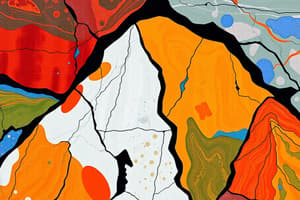Podcast
Questions and Answers
What does metamorphic grade primarily refer to?
What does metamorphic grade primarily refer to?
- The size of the rock crystals
- The specific chemical composition of the rock
- The temperature and pressure conditions (correct)
- The color of the metamorphic rock
What is the process called when rocks change to another metamorphic rock at higher grades?
What is the process called when rocks change to another metamorphic rock at higher grades?
- Prograde metamorphism (correct)
- Retrograde metamorphism
- Isograd metamorphism
- Contact metamorphism
At approximately what temperature range does low-grade metamorphism occur?
At approximately what temperature range does low-grade metamorphism occur?
- 320-450°C
- 200-320°C (correct)
- Below 100°C
- Above 450°C
What is a common characteristic of low-grade metamorphic rocks?
What is a common characteristic of low-grade metamorphic rocks?
Which minerals are typically replaced by micas and non-hydrous minerals during medium-grade metamorphism?
Which minerals are typically replaced by micas and non-hydrous minerals during medium-grade metamorphism?
What approximate temperature is associated with high-grade metamorphism?
What approximate temperature is associated with high-grade metamorphism?
What generally happens to micas during high-grade metamorphism?
What generally happens to micas during high-grade metamorphism?
What is an index mineral an indicator of?
What is an index mineral an indicator of?
What mineral characterizes the lowest regional metamorphic grade?
What mineral characterizes the lowest regional metamorphic grade?
Which mineral is characteristic of high-grade metamorphic rocks?
Which mineral is characteristic of high-grade metamorphic rocks?
What term describes the lines that geologists draw to delineate zones of different metamorphic grades?
What term describes the lines that geologists draw to delineate zones of different metamorphic grades?
What is the primary setting for regional metamorphism?
What is the primary setting for regional metamorphism?
What causes contact metamorphism?
What causes contact metamorphism?
What is the zone of contact metamorphism surrounding an igneous intrusion called?
What is the zone of contact metamorphism surrounding an igneous intrusion called?
What type of metamorphism involves the interaction of rock with high-temperature fluids?
What type of metamorphism involves the interaction of rock with high-temperature fluids?
What is a common metamorphic rock that results from hydrothermal metamorphism of ocean floor basalts?
What is a common metamorphic rock that results from hydrothermal metamorphism of ocean floor basalts?
What type of stress characterizes burial metamorphism?
What type of stress characterizes burial metamorphism?
What is the main type of mineral that grows during burial metamorphism?
What is the main type of mineral that grows during burial metamorphism?
Subduction zone metamorphism is characterized by which conditions?
Subduction zone metamorphism is characterized by which conditions?
What type of metamorphic rock is typically formed in subduction zones and contains the blue amphibole glaucophane?
What type of metamorphic rock is typically formed in subduction zones and contains the blue amphibole glaucophane?
Flashcards
Metamorphic Grade
Metamorphic Grade
General temperature and pressure during metamorphism.
Prograde Metamorphism
Prograde Metamorphism
Changing from one type of metamorphic rock to another at higher grades.
Low-Grade Metamorphism
Low-Grade Metamorphism
Occurs at 200–320 ºC and relatively low pressure; rocks look like protolith.
Medium-Grade Metamorphism
Medium-Grade Metamorphism
Signup and view all the flashcards
High-Grade Metamorphism
High-Grade Metamorphism
Signup and view all the flashcards
Index Minerals
Index Minerals
Signup and view all the flashcards
Chlorite
Chlorite
Signup and view all the flashcards
Isograds
Isograds
Signup and view all the flashcards
Regional Metamorphism
Regional Metamorphism
Signup and view all the flashcards
Contact Metamorphism
Contact Metamorphism
Signup and view all the flashcards
Metamorphic Aureole
Metamorphic Aureole
Signup and view all the flashcards
Hydrothermal Metamorphism
Hydrothermal Metamorphism
Signup and view all the flashcards
Burial Metamorphism
Burial Metamorphism
Signup and view all the flashcards
Subduction Zone Metamorphism
Subduction Zone Metamorphism
Signup and view all the flashcards
Metamorphic Facies
Metamorphic Facies
Signup and view all the flashcards
Greenschist
Greenschist
Signup and view all the flashcards
Blueschist Facies
Blueschist Facies
Signup and view all the flashcards
Geothermal Gradient
Geothermal Gradient
Signup and view all the flashcards
Study Notes
Grades of Metamorphism
- Metamorphic grade is the general temperature and pressure during metamorphism.
- Rocks metamorphose to a higher grade as temperature and pressure increase.
- Prograde metamorphism occurs when rocks change to another as they experience higher metamorphic grades.
Low-Grade Metamorphism
- Low-grade metamorphism occurs at approximately 200–320 ºC and relatively low pressure.
- Conditions are not far beyond those of lithified sedimentary rocks.
- Low-grade metamorphic rocks often resemble their protolith.
- Abundant hydrous minerals characterize low-grade metamorphic rocks.
- Examples of hydrous minerals include clay, serpentine, and chlorite.
- Metamorphic minerals often remain too small to be seen without a microscope in low-grade metamorphism.
Medium-Grade Metamorphism
- Medium-grade metamorphism takes place at approximately 320–450 ºC and at moderate pressures.
- Micas like biotite and muscovite replace low-grade hydrous minerals.
- Non-hydrous minerals such as garnet may grow.
- Garnet can form porphyroblasts, which are larger and more equant grains that stand out.
High-Grade Metamorphism
- High-grade metamorphism occurs at temperatures above about 450 ºC.
- Micas tend to break down at this grade.
- Hornblende, stable at higher temperatures, forms.
- At even higher grades, hydrous minerals like hornblende may break down.
- Higher-temperature, non-hydrous minerals such as pyroxene may replace hydrous minerals.
Index Minerals
- Index minerals indicate metamorphic grade.
- Lower-grade index minerals are replaced by higher-grade minerals during prograde metamorphism in rocks of a specific chemical composition.
- In metamorphosed shale, index minerals prograde in the following sequence:
- Chlorite characterizes the lowest regional metamorphic grade.
- Biotite replaces chlorite at the next metamorphic grade, considered medium-low grade
- Garnet appears at the next metamorphic grade, medium grade
- Staurolite marks the next metamorphic grade, which is medium-high grade
- Sillimanite characterizes high-grade metamorphic rocks
Mapping with Index Minerals
- Geologists use index minerals to map metamorphic grades in metamorphic rock regions.
- Geologists map, collect rock samples, and mark the geologic map with sample locations and index mineral types
- Geologists delineate metamorphic grade zones by drawing lines around areas with the same index minerals.
- These lines are known as isograds.
Regional Metamorphism
- Regional metamorphism affects large rock areas subjected to differential stress over long periods.
- This commonly occurs during mountain building at subduction and continental collision zones.
- Foliated metamorphic rocks like slate, phyllite, schist, and gneiss form during regional metamorphism.
- Rocks become ductile when heated deep in the Earth in regional metamorphism.
- Folding and deformation can distort rock shapes, creating folded layers and mineral veins.
Contact Metamorphism
- Contact metamorphism occurs in solid rock near igneous intrusions, caused by the magma's heat.
- Contact metamorphic rocks do not become foliated because there are no changes in pressure or differential stress.
- The zone of contact metamorphism is relatively narrow in shallow intrusions (a few meters).
- Contact metamorphic zones around larger intrusions can be over 1000 m thick.
- The metamorphic aureole is the zone of contact metamorphism around an intrusion.
- The highest metamorphic grade is closest to the intrusion contact, decreasing with distance.
- Contact metamorphism is high-temperature, low-pressure, occurring at shallow to moderate depths.
- Hornfels, a hard metamorphic rock from fine-grained clastic sedimentary rocks, commonly forms.
Hydrothermal Metamorphism
- Hydrothermal metamorphism results from extensive interaction between rock and high-temperature fluids.
- Chemical reactions occur due to compositional differences between the existing rock and invading fluid.
- Hydrothermal fluid may come from nearby magma, hot groundwater, or ocean water.
- Metasomatism occurs if the fluid introduces or removes substantial amounts of ions, changing the rock's chemical composition.
- Ocean water circulating through hot, cracked oceanic crust creates hydrothermal metamorphism near mid-ocean ridges and volcanic zones.
- Basalt subjected to this metamorphism often turns into greenschist.
- Greenschist contains green minerals like chlorite, epidote, talc, Na-plagioclase, or actinolite.
- Fluids escape through black smokers, forming thick mineral deposits on the ocean floor.
Burial Metamorphism
- Burial metamorphism occurs in rocks buried beneath sediments, exceeding sedimentary rock formation conditions.
- Rocks experience uniform lithostatic pressure, so foliation does not develop.
- This is the lowest grade of metamorphism.
- Zeolite, a group of low-density silicate minerals, typically grows.
- A strong microscope is needed to see small zeolite grains.
Subduction Zone Metamorphism
- During subduction, a tectonic plate of oceanic crust and lithospheric mantle is recycled.
- The subducting plate is relatively cold compared to its formation temperature at a mid-ocean ridge.
- Subduction leads to high-pressure, low-temperature metamorphism deep in subduction zones.
- Oceanic basalts in a subducting plate develop distinctive minerals like glaucophane, a blue amphibole.
- Blueschist is a metamorphic rock type formed in subduction zones.
- Blueschist indicates a past subduction zone, even if plate boundaries have shifted.
Metamorphic Facies
- Minerals and textures in metamorphic rocks reveal pressure, temperature, fluids, and stress conditions.
- Specific metamorphic rocks form under specific pressure and temperature conditions.
- These conditions are determined by experiments, calculations, rock textures, and field relations.
- Metamorphic facies is a concept based on the temperatures and pressures at which metamorphic rocks form.
- Each metamorphic facies is represented by a specific metamorphic rock type formed under specific pressure and temperature conditions.
- The name of each metamorphic facies comes from a rock type that forms under those conditions, but other rock types can also form.
- Basalt protoliths become greenschist under greenschist facies conditions.
- Shale protoliths become muscovite-biotite schist, not green, under greenschist facies conditions.
- A muscovite-biotite schist formed at 350ºC and 400 MPa is in the greenschist facies, even if it is not greenschist itself.
- Earth's surface is at 15ºC and 0.1 MPa.
- Pressure inside the Earth comes from the weight of overlying rock, and MPa is the unit of pressure.
- 1 MPa is nearly 10 atmospheres, and 1000 MPa is about 35 km deep.
- Temperature depends on depth and heat flow.
- The geothermal gradient is the way temperature changes with depth and varies by location.
- High-pressure, low-temperature geotherms occur in subduction zones, leading to zeolite, blueschist, and eclogite facies.
- High-temperature, low-pressure geotherms occur near igneous intrusions, leading to hornfels and granulite facies.
- Blueschist and hornfels facies have unusual geothermal gradients.
- Most regional metamorphic rocks form between these extremes, passing through greenschist to amphibolite facies.
- At maximum pressures and temperatures, rocks enter granulite or eclogite facies.
- Regionally metamorphosed rocks with hydrous fluids begin to melt before passing the amphibolite facies.
Studying That Suits You
Use AI to generate personalized quizzes and flashcards to suit your learning preferences.




